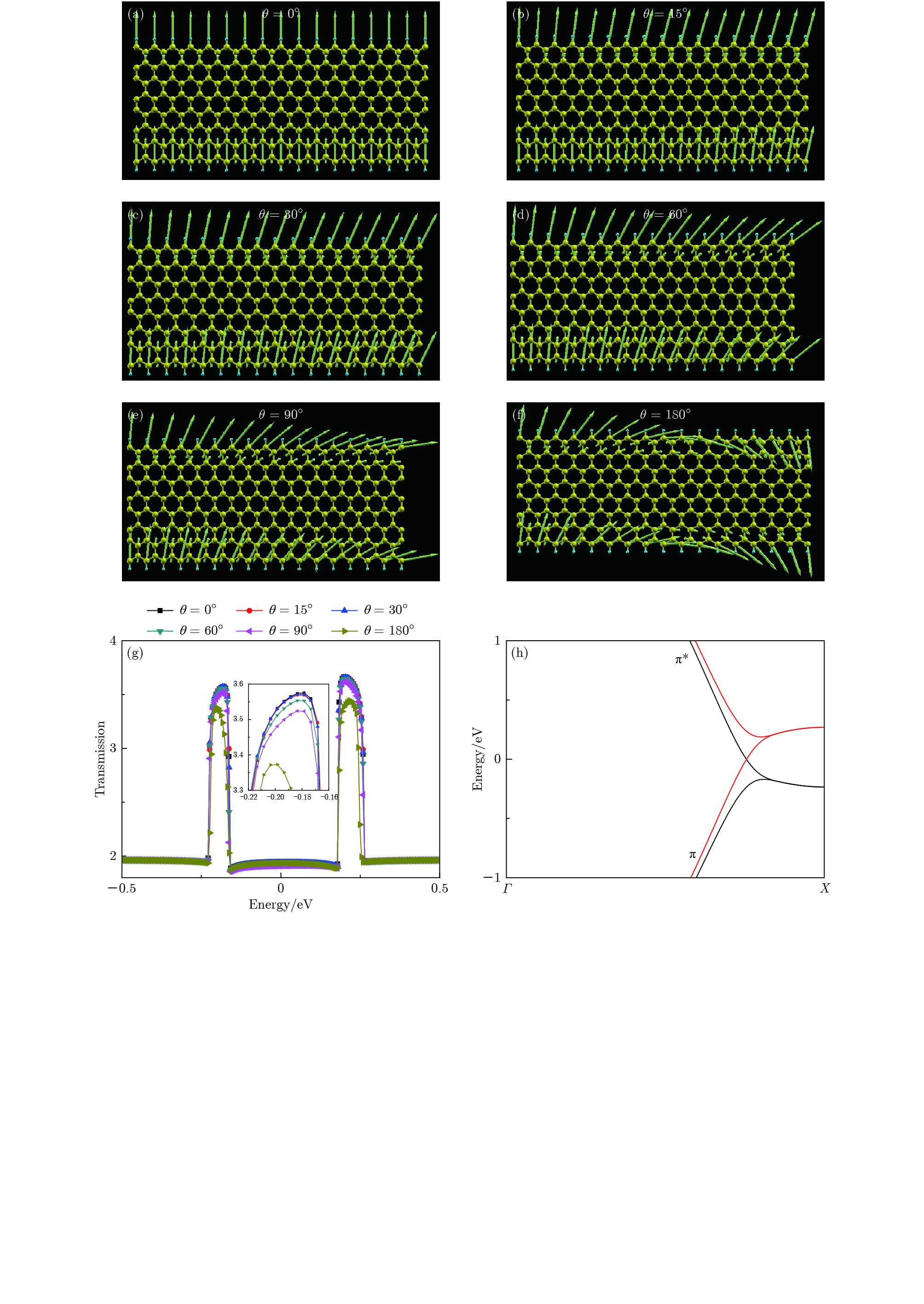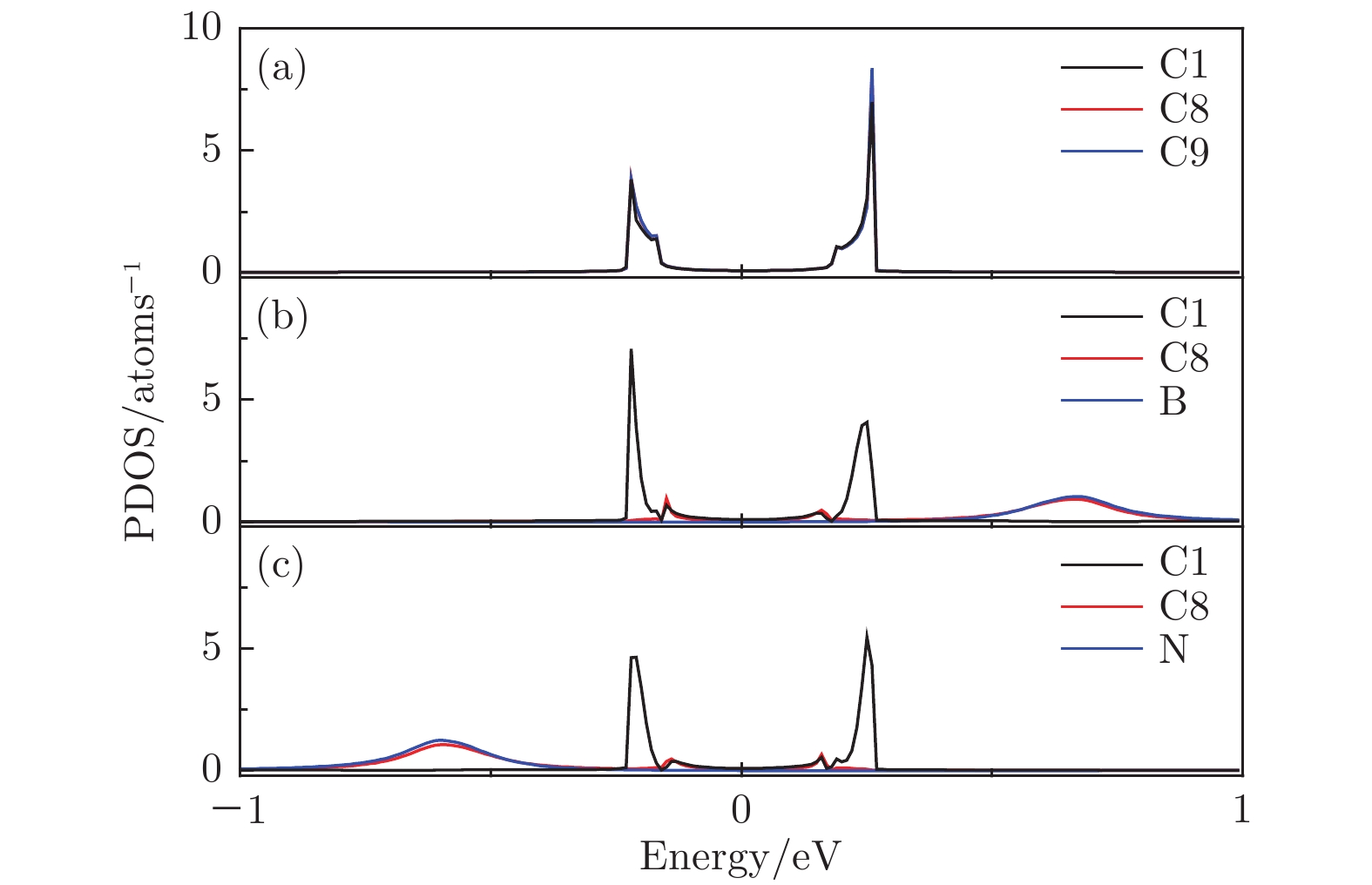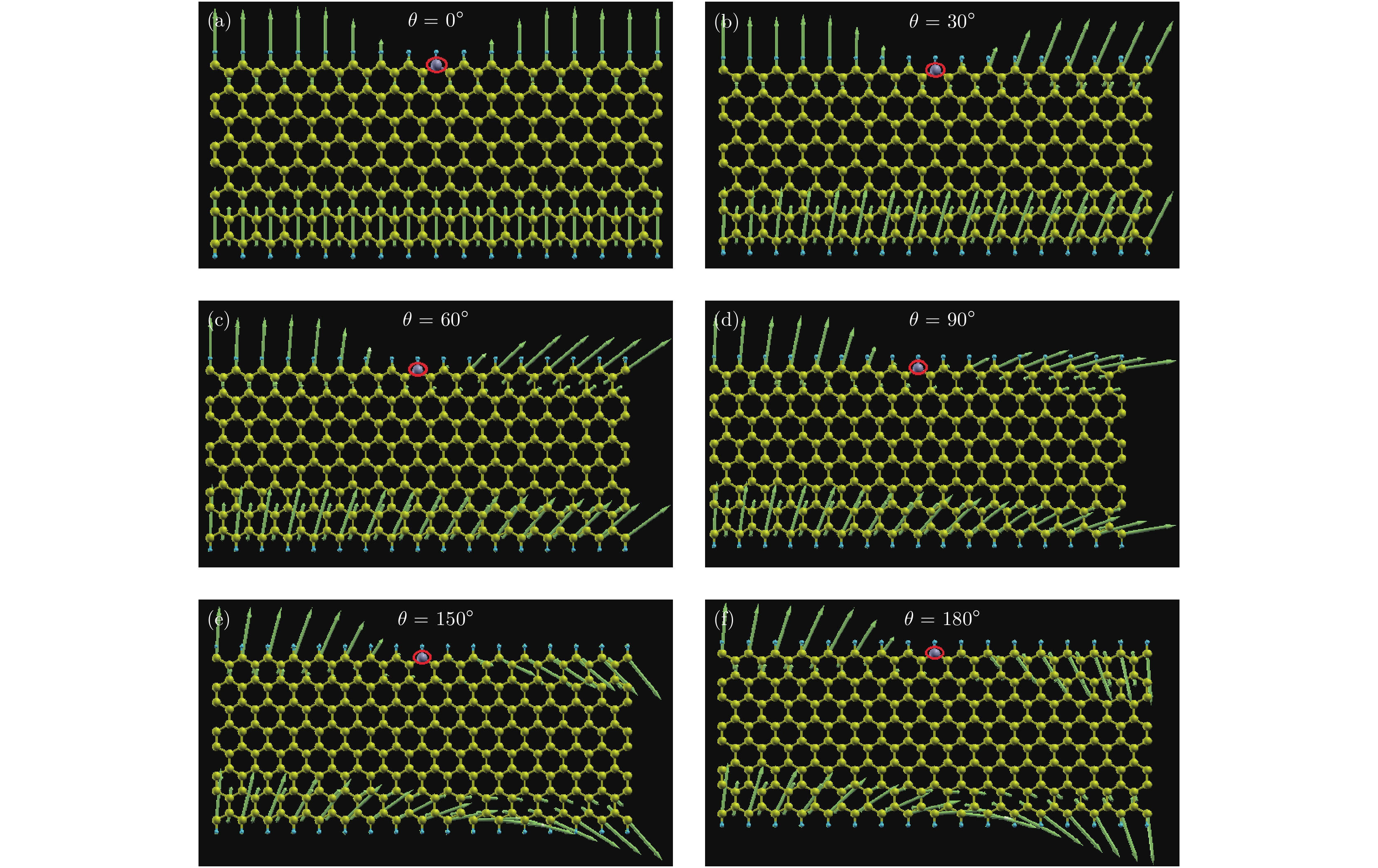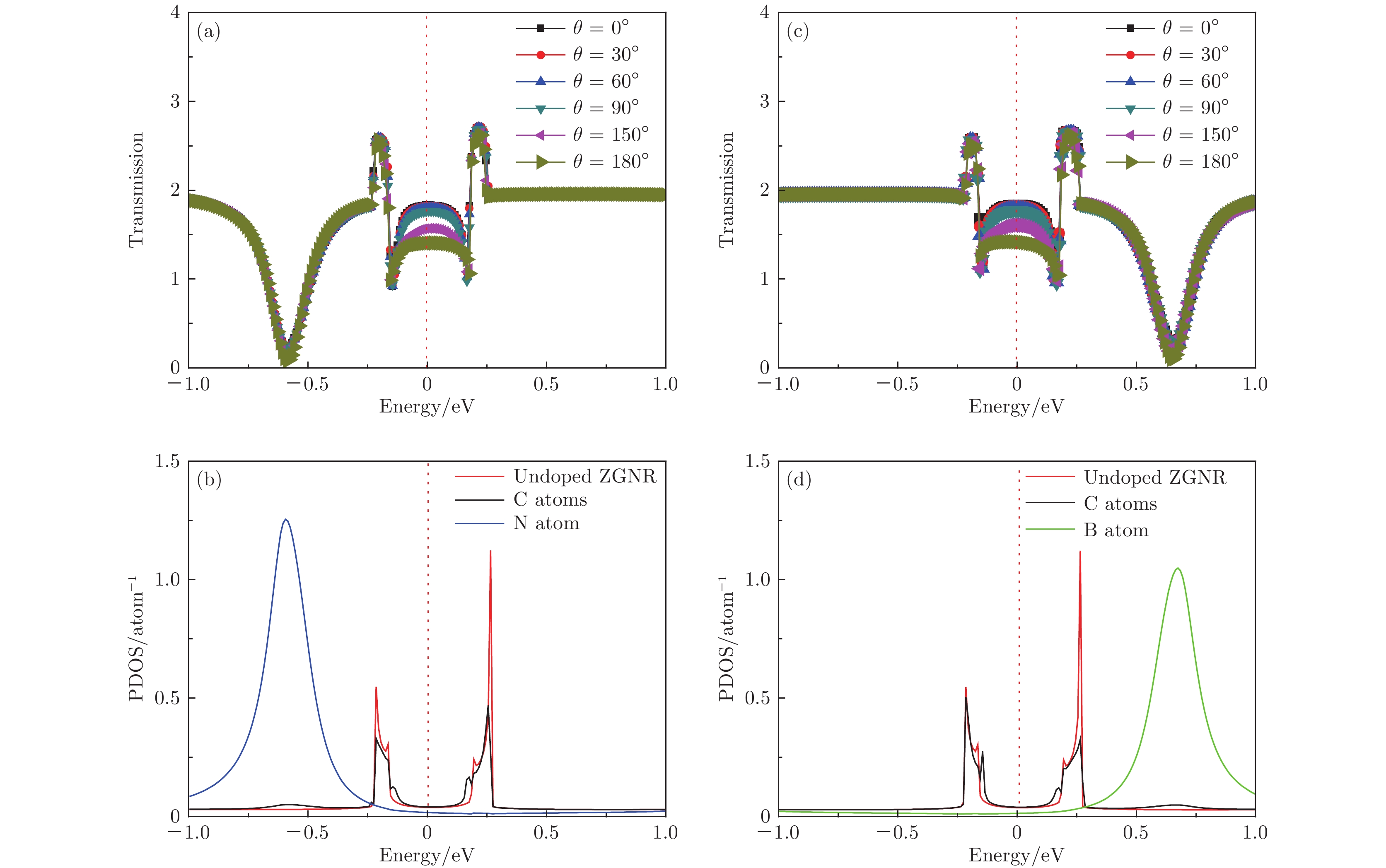-
基于非共线磁序密度泛函/非平衡格林函数方法, 研究了硼或氮掺杂的锯齿型石墨烯纳米带的非共线磁序与电子透射系数. 未掺杂的石墨烯纳米带的计算结果表明磁化分布主要遵循类似于Neel磁畴壁的螺旋式磁化分布. 相比于未掺杂的情况, 硼/氮掺杂的石墨烯纳米带的磁化分布出现了双区域的特征, 即杂质原子附近的磁化较小, 杂质原子左(右)侧区域的磁化分布更接近于左(右)电极的磁化方向, 这为通过掺杂手段在石墨烯纳米带边缘上构建不同磁畴壁提供了可能性. 与未掺杂的透射系数不同的是, 硼/氮掺杂的石墨烯纳米带的透射系数在费米面附近随着磁化偏转角增大而减小, 表明非共线磁序引起的自旋翻转散射占据主导地位. 而在E = ±0.65 eV处, 出现了一个较宽的dip结构, 投影电子态密度的分析表明其来源于杂质原子形成的束缚态所引起的背散射. 我们的研究结果对于理解石墨烯纳米带中的非共线磁序与杂质散射以及器件设计具有一定的意义.Zigzag graphene nanoribbon (ZGNR) is important for novel carbon-based spintronic applications. Currently, most of ZGNR spintronic studies focus on the collinear magnetism where the up-spin and down-spin are separated clearly. But in some cases, e.g. doping and adsorption, the magnetization profile can be modulated and thus noncollinear magnetism can occur. In order to shed light on possible noncollinear magnetism in ZGNR, we study non-collinear magnetism and electronic transport of boron or nitrogen-doped zigzag graphene nanoribbon based on noncollinear density functional theory and non-equilibrium Green's function method. For pristine ZGNR, our results show that the ZGNR presents helical magnetization distribution due to noncollinear magnetization in left and right lead. As the ZGNR is doped with boron and nitrogen atoms, the ZGNR shows a characteristic two-zone feature in the magnetization distribution. Near the dopant site, the magnetic moment of carbon atom is small. However, the magnetic moments of carbon atoms in the left (right) region of dopant are close to those of the left (right) lead. Such a feature provides the possibility of constructing domain walls with various widths on the edge of ZGNR. Moreover, the transmission at the Fermi level (E = 0 eV) decreases with the increase of relative angle between magnetizations of left and right lead, indicating that the spin-flip scattering dominates the electronic transport. However, at E = ±0.65 eV, there is a transmission dip with low transmission, which implies that the dopant induces the strong backscattering. To understand the origin of this dip, we calculate the density of states (DOS) and project the DOS onto each atom of doped ZGNR. The projected DOS shows a large and broad peak at E = −0.65 eV for N-doped ZGNR but at E = +0.65 eV for B-doped ZGNR. The consistency between the position of dip in transmission and the position of peak in DOS indicates that the transmission dip mentioned above is attributed to strong backscattering from the dopant-induced bound state. Our theoretical results are expected to be useful for understanding the noncollinear magnetism and spin scattering in the doped ZGNR-based devices. Also, our work provides a considerable insight into the design of ZGNR-based nanoelectronic devices, such as the transistor based on spin transfer torque effect.
-
Keywords:
- graphene nanoribbon /
- electronic transport /
- density functional /
- non-equilibrium Green’s function
[1] Peng B, Zhang H, Shao H Z, Xu Y F, Ni G, Zhang R, Zhu H Y 2016 Phys. Rev. B 94 245420
 Google Scholar
Google Scholar
[2] Wang W X, Zhou M, Li X Q, Li S Y, Wu X S, Duan W H, He L 2016 Phys. Rev. B 93 241403
 Google Scholar
Google Scholar
[3] Cui P, Zhang Q, Zhu H B, Li X X, Wang W Y, Li Q X, Zeng C G, Zhang Z Y 2016 Phys. Rev. Lett. 116 026802
 Google Scholar
Google Scholar
[4] Pan J B, Du S X, Zhang Y Y, Pan L D, Zhang Y F, Gao H J, Pantelides S T 2015 Phys. Rev. B 92 205429
 Google Scholar
Google Scholar
[5] Chen X B, Liu Y Z, Gu B L, Duan W H, Liu F 2014 Phys. Rev. B 90 121403
 Google Scholar
Google Scholar
[6] Wang Z F, Jin S, Liu F 2013 Phys. Rev. Lett. 111 096803
 Google Scholar
Google Scholar
[7] Yue Q, Chang S G, Tan J C, Qin S Q, Kang J, Li J B 2012 Phys. Rev. B 86 235448
 Google Scholar
Google Scholar
[8] Hu X H, Zhang W, Sun L T, Krasheninnikov A V 2012 Phys. Rev. B 86 195418
 Google Scholar
Google Scholar
[9] Hu T, Zhou J, Dong J M, Kawazoe Y 2012 Phys. Rev. B 86 125420
 Google Scholar
Google Scholar
[10] Zheng X H, Wang X L, Huang L F, Hao H, Lan J, Zeng Z 2012 Phys. Rev. B 86 081408
 Google Scholar
Google Scholar
[11] Zhou J, Hu T, Dong J M, Kawazoe Y 2012 Phys. Rev. B 86 035434
 Google Scholar
Google Scholar
[12] Liu Y, Wang G, Huang Q S, Guo L W, Chen X L 2012 Phys. Rev. Lett. 108 225505
 Google Scholar
Google Scholar
[13] Cheng Y C, Wang H T, Zhu Z Y, Zhu Y H, Han Y, Zhang X X, Schwingenschlgl U 2012 Phys. Rev. B 85 073406
 Google Scholar
Google Scholar
[14] Xiang H J, Huang B, Li Z Y, Wei S H, Yang J L, Gong X G 2012 Phys. Rev. X 2 011003
 Google Scholar
Google Scholar
[15] Zhang J C, Huang X P, Yue Y A, Wang J M, Wang X W 2011 Phys. Rev. B 84 235416
 Google Scholar
Google Scholar
[16] Lin X Q, Ni J 2011 Phys. Rev. B 84 075461
 Google Scholar
Google Scholar
[17] Li Y C, Chen X B, Zhou G, Duan W H, Kim Y, Kim M, Ihm J 2011 Phys. Rev. B 83 195443
 Google Scholar
Google Scholar
[18] Li W, Sevinli H, Roche S, Cuniberti G 2011 Phys. Rev. B 83 155416
 Google Scholar
Google Scholar
[19] Zhang Z H, Guo W L, Zeng X C 2010 Phys. Rev. B 82 235423
 Google Scholar
Google Scholar
[20] Wang Z F, Li Q X, Zheng H X, Ren H, Su H B, Shi Q W, Chen J 2007 Phys. Rev. B 75 113406
 Google Scholar
Google Scholar
[21] Fujita M, Wakabayashi K, Nakada K, Kusakabe K 1996 J. Phys. Soc. Jpn. 65 1920
 Google Scholar
Google Scholar
[22] Tombros N, Jozsa C, Popinciuc M, Jonkman H T, van Wees B J 2007 Nature 448 571
 Google Scholar
Google Scholar
[23] Huang B, Liu F, Wu J, Gu B L, Duan W H 2008 Phys. Rev. B 77 153411
 Google Scholar
Google Scholar
[24] Ozaki T, Nishio K, Weng H M, Kino H 2010 Phys. Rev. B 81 075422
 Google Scholar
Google Scholar
[25] 邓小清, 孙琳, 李春先 2016 65 068503
 Google Scholar
Google Scholar
Deng X Q, Sun L, Li C X 2016 Acta Phys. Sin. 65 068503
 Google Scholar
Google Scholar
[26] 李彪, 徐大海, 曾晖 2014 63 117102
 Google Scholar
Google Scholar
Li B, Xu D H, Zeng H 2014 Acta Phys. Sin. 63 117102
 Google Scholar
Google Scholar
[27] 林琦, 陈余行, 吴建宝, 孔宗敏 2011 60 097103
Lin Q, Chen Y X, Wu J B, Kong Z M 2011 Acta Phys. Sin. 60 097103 (in Chinese)
[28] 李骏, 张振华, 王成志, 邓小清, 范志强 2013 62 036103
Li J, Zhang Z H, Wang C Z, Deng X Q, Fan Z Q 2013 Acta Phys. Sin. 62 036103 (in Chinese)
[29] 胡小会, 许俊敏, 孙立涛 2012 61 047106
Hu X H, Xu J M, Su L T 2012 Acta Phys. Sin. 61 047106 (in Chinese)
[30] 王鼎, 张振华, 邓小清, 范志强 2013 62 207101
 Google Scholar
Google Scholar
Wang D, Zhang Z H, Deng X Q, Fan Z Q 2013 Acta. Phys. Sin. 62 207101
 Google Scholar
Google Scholar
[31] Yazyev O V, Katsnelson M I 2008 Phys. Rev. Lett. 100 047209
 Google Scholar
Google Scholar
[32] Zhang Y, Yan X H, Guo Y D, Xiao Y 2017 J. Appl. Phys. 121 174303
 Google Scholar
Google Scholar
[33] Li H D, Wang L, Lan Z H, Zheng Y S 2009 Phys. Rev. B 79 155429
 Google Scholar
Google Scholar
[34] Xu B, Yin J, Weng H G, Xia Y D, Wan X G, Liu Z G 2010 Phys. Rev. B 81 205419
 Google Scholar
Google Scholar
[35] Wang B, Wang J, Guo H 2009 Phys. Rev. B 79 165417
 Google Scholar
Google Scholar
[36] Ozaki T, Kino H 2005 Phys. Rev. B 72 045121
 Google Scholar
Google Scholar
[37] Tersoff J, Hamann D R 1985 Phys. Rev. B 31 805
 Google Scholar
Google Scholar
[38] Chantis A N, Smith D L, Fransson J, Balatsky A V 2009 Phys. Rev. B 79 165423
 Google Scholar
Google Scholar
[39] Slonczewski J C 1989 Phys. Rev. B 39 6995
 Google Scholar
Google Scholar
[40] Press M R, Liu F, Khanna S N, Jena P 1989 Phys. Rev. B 40 399
 Google Scholar
Google Scholar
-
图 1 掺杂石墨烯纳米带的结构示意图, 其结构由左右电极、中心区组成, 左右电极磁化之间的偏转角由
$\theta$ 定义, 中心区宽度由Ly给出, buffer是为了计算收敛加入的缓冲区, 红色小球代表掺杂原子Fig. 1. Schematic diagram of doped ZGNR which consists of left, right leads and central region. The relative angle between two lead magnetizations is defined by
$\theta$ . The length of central region is defined by Ly. The buffer regions are introduced for the consideration of convergence. The dopant atom is denoted by red sphere.图 4 石墨烯纳米带投影到几个原子上的电子态密度 (a) 未掺杂; (b) 硼掺杂; (c) 氮掺杂. C1代表中心区上边缘的最左边的碳原子, C8代表掺杂原子左侧的最近邻碳原子, B/N代表掺杂原子, C9代表未掺杂时上边缘最中心的碳原子
Fig. 4. Projected density of states: (a) Undoped; (b) B-doped; (c) N-doped ZGNR. C1 denotes the leftmost carbon atom on the upper edge. C8 denotes the left nearest neighboring carbon atom of the dopant. B/N is boron/nitrogen atom. C9 denotes the central carbon atom in the upper edge of undoped ZGNR.
-
[1] Peng B, Zhang H, Shao H Z, Xu Y F, Ni G, Zhang R, Zhu H Y 2016 Phys. Rev. B 94 245420
 Google Scholar
Google Scholar
[2] Wang W X, Zhou M, Li X Q, Li S Y, Wu X S, Duan W H, He L 2016 Phys. Rev. B 93 241403
 Google Scholar
Google Scholar
[3] Cui P, Zhang Q, Zhu H B, Li X X, Wang W Y, Li Q X, Zeng C G, Zhang Z Y 2016 Phys. Rev. Lett. 116 026802
 Google Scholar
Google Scholar
[4] Pan J B, Du S X, Zhang Y Y, Pan L D, Zhang Y F, Gao H J, Pantelides S T 2015 Phys. Rev. B 92 205429
 Google Scholar
Google Scholar
[5] Chen X B, Liu Y Z, Gu B L, Duan W H, Liu F 2014 Phys. Rev. B 90 121403
 Google Scholar
Google Scholar
[6] Wang Z F, Jin S, Liu F 2013 Phys. Rev. Lett. 111 096803
 Google Scholar
Google Scholar
[7] Yue Q, Chang S G, Tan J C, Qin S Q, Kang J, Li J B 2012 Phys. Rev. B 86 235448
 Google Scholar
Google Scholar
[8] Hu X H, Zhang W, Sun L T, Krasheninnikov A V 2012 Phys. Rev. B 86 195418
 Google Scholar
Google Scholar
[9] Hu T, Zhou J, Dong J M, Kawazoe Y 2012 Phys. Rev. B 86 125420
 Google Scholar
Google Scholar
[10] Zheng X H, Wang X L, Huang L F, Hao H, Lan J, Zeng Z 2012 Phys. Rev. B 86 081408
 Google Scholar
Google Scholar
[11] Zhou J, Hu T, Dong J M, Kawazoe Y 2012 Phys. Rev. B 86 035434
 Google Scholar
Google Scholar
[12] Liu Y, Wang G, Huang Q S, Guo L W, Chen X L 2012 Phys. Rev. Lett. 108 225505
 Google Scholar
Google Scholar
[13] Cheng Y C, Wang H T, Zhu Z Y, Zhu Y H, Han Y, Zhang X X, Schwingenschlgl U 2012 Phys. Rev. B 85 073406
 Google Scholar
Google Scholar
[14] Xiang H J, Huang B, Li Z Y, Wei S H, Yang J L, Gong X G 2012 Phys. Rev. X 2 011003
 Google Scholar
Google Scholar
[15] Zhang J C, Huang X P, Yue Y A, Wang J M, Wang X W 2011 Phys. Rev. B 84 235416
 Google Scholar
Google Scholar
[16] Lin X Q, Ni J 2011 Phys. Rev. B 84 075461
 Google Scholar
Google Scholar
[17] Li Y C, Chen X B, Zhou G, Duan W H, Kim Y, Kim M, Ihm J 2011 Phys. Rev. B 83 195443
 Google Scholar
Google Scholar
[18] Li W, Sevinli H, Roche S, Cuniberti G 2011 Phys. Rev. B 83 155416
 Google Scholar
Google Scholar
[19] Zhang Z H, Guo W L, Zeng X C 2010 Phys. Rev. B 82 235423
 Google Scholar
Google Scholar
[20] Wang Z F, Li Q X, Zheng H X, Ren H, Su H B, Shi Q W, Chen J 2007 Phys. Rev. B 75 113406
 Google Scholar
Google Scholar
[21] Fujita M, Wakabayashi K, Nakada K, Kusakabe K 1996 J. Phys. Soc. Jpn. 65 1920
 Google Scholar
Google Scholar
[22] Tombros N, Jozsa C, Popinciuc M, Jonkman H T, van Wees B J 2007 Nature 448 571
 Google Scholar
Google Scholar
[23] Huang B, Liu F, Wu J, Gu B L, Duan W H 2008 Phys. Rev. B 77 153411
 Google Scholar
Google Scholar
[24] Ozaki T, Nishio K, Weng H M, Kino H 2010 Phys. Rev. B 81 075422
 Google Scholar
Google Scholar
[25] 邓小清, 孙琳, 李春先 2016 65 068503
 Google Scholar
Google Scholar
Deng X Q, Sun L, Li C X 2016 Acta Phys. Sin. 65 068503
 Google Scholar
Google Scholar
[26] 李彪, 徐大海, 曾晖 2014 63 117102
 Google Scholar
Google Scholar
Li B, Xu D H, Zeng H 2014 Acta Phys. Sin. 63 117102
 Google Scholar
Google Scholar
[27] 林琦, 陈余行, 吴建宝, 孔宗敏 2011 60 097103
Lin Q, Chen Y X, Wu J B, Kong Z M 2011 Acta Phys. Sin. 60 097103 (in Chinese)
[28] 李骏, 张振华, 王成志, 邓小清, 范志强 2013 62 036103
Li J, Zhang Z H, Wang C Z, Deng X Q, Fan Z Q 2013 Acta Phys. Sin. 62 036103 (in Chinese)
[29] 胡小会, 许俊敏, 孙立涛 2012 61 047106
Hu X H, Xu J M, Su L T 2012 Acta Phys. Sin. 61 047106 (in Chinese)
[30] 王鼎, 张振华, 邓小清, 范志强 2013 62 207101
 Google Scholar
Google Scholar
Wang D, Zhang Z H, Deng X Q, Fan Z Q 2013 Acta. Phys. Sin. 62 207101
 Google Scholar
Google Scholar
[31] Yazyev O V, Katsnelson M I 2008 Phys. Rev. Lett. 100 047209
 Google Scholar
Google Scholar
[32] Zhang Y, Yan X H, Guo Y D, Xiao Y 2017 J. Appl. Phys. 121 174303
 Google Scholar
Google Scholar
[33] Li H D, Wang L, Lan Z H, Zheng Y S 2009 Phys. Rev. B 79 155429
 Google Scholar
Google Scholar
[34] Xu B, Yin J, Weng H G, Xia Y D, Wan X G, Liu Z G 2010 Phys. Rev. B 81 205419
 Google Scholar
Google Scholar
[35] Wang B, Wang J, Guo H 2009 Phys. Rev. B 79 165417
 Google Scholar
Google Scholar
[36] Ozaki T, Kino H 2005 Phys. Rev. B 72 045121
 Google Scholar
Google Scholar
[37] Tersoff J, Hamann D R 1985 Phys. Rev. B 31 805
 Google Scholar
Google Scholar
[38] Chantis A N, Smith D L, Fransson J, Balatsky A V 2009 Phys. Rev. B 79 165423
 Google Scholar
Google Scholar
[39] Slonczewski J C 1989 Phys. Rev. B 39 6995
 Google Scholar
Google Scholar
[40] Press M R, Liu F, Khanna S N, Jena P 1989 Phys. Rev. B 40 399
 Google Scholar
Google Scholar
计量
- 文章访问数: 12902
- PDF下载量: 108
- 被引次数: 0













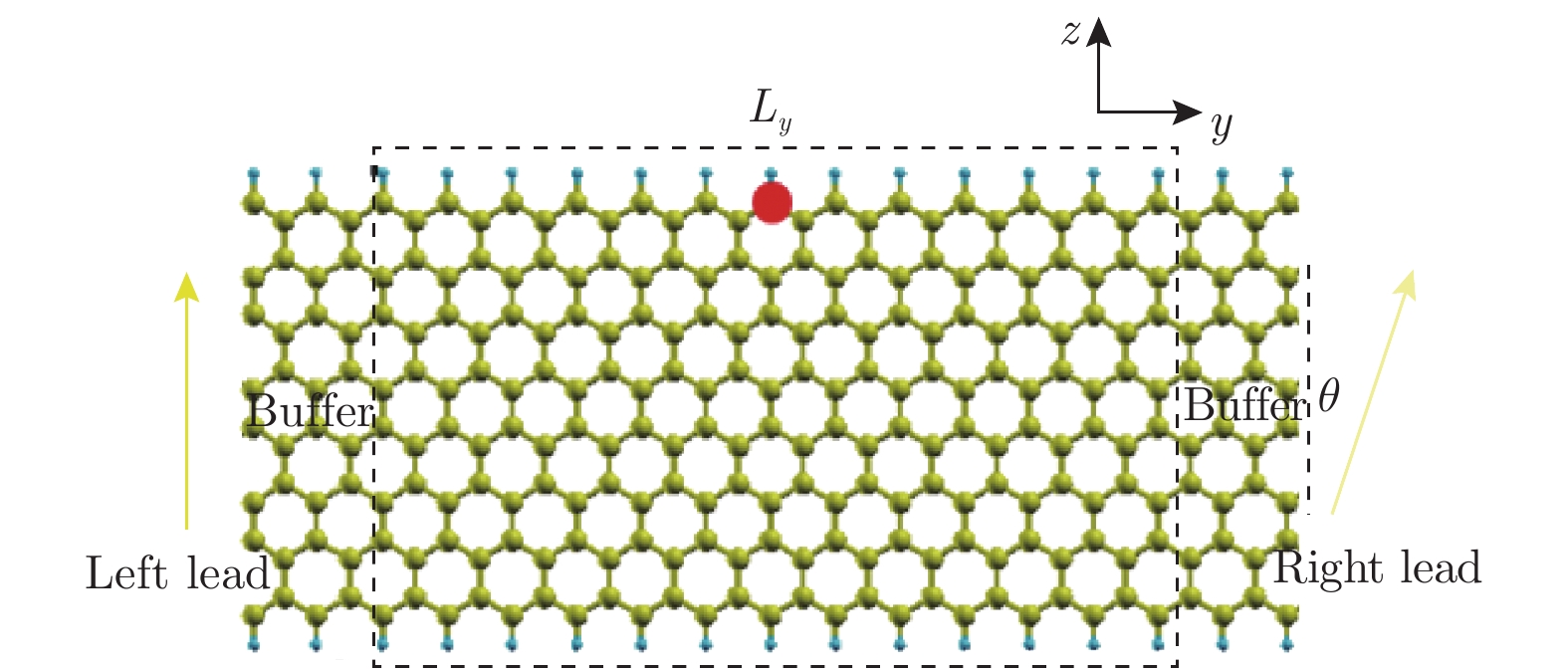


 下载:
下载:
